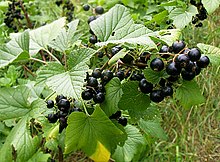Currants
| Currants | ||||||||||||
|---|---|---|---|---|---|---|---|---|---|---|---|---|
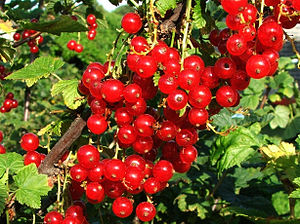
Red currant ( Ribes rubrum ) |
||||||||||||
| Systematics | ||||||||||||
|
||||||||||||
| Scientific name of the family | ||||||||||||
| Grossulariaceae | ||||||||||||
| DC. | ||||||||||||
| Scientific name of the genus | ||||||||||||
| Ribes | ||||||||||||
| L. |
The currants ( Ribes ), in Bavaria, Austria and South Tyrol the Ribisl (plural: Ribisln), in Baden-Württemberg Träuble , in Switzerland Meertrübeli , Trübeli or Ribiseli , are the only genus of plants in the gooseberry family (Grossulariaceae). It includes the types called currant and gooseberry in German . Some species and their varieties are as berries fruit , other than ornamental plants used.
description

Vegetative characteristics
The Ribes species are mostly deciduous, rarely evergreen ( Ribes viburnifolium ) or almost evergreen ( Ribes speciosum ) shrubs that reach heights of 1 to 1.5 meters, or rarely small trees . Few species live as epiphytes . Usually short and long shoots are formed. Some of the species are armed with thorns. The buds have paper-like to herbaceous scales; in them the leaves are usually folded. The alternate and spiral or seldom several grouped leaves , arranged on the branches are divided into petioles and leaf blades. The leaf blade is simple ( Ribes speciosum , Ribes viburnifolium ), often three to five times lobed; in some species they have a distinctive odor. Stipules are usually missing.
Generative characteristics
Usually simple, racemose , almost sessile, umbellate or umbellate inflorescences are formed, in some species the inflorescence is reduced to one or a few flowers. There are two bracts under each flower .

The flowers are hermaphroditic or unisexual; if the flowers are unisexual (for example Ribes diacanthum ), then the plants are dioeciously separated ( dioecious ). There is a free flower cup (hypanthium). There is only one circle with four or five fertile stamens . The radial symmetry flowers are four or five-fold in principle with double perianth . The four to five, mostly corolla-like, greenish, white, yellow, from pink to red to purple-colored sepals are fused with each other and with the base of the ovary . The calyx lobes are erect or bent back. There are four or five greenish, white, yellow, from pink to red to purple-colored petals present or they are absent in some species. There is only the outer circle with four to five fertile stamens . In functionally female flowers, the stamens are sterile. Two carpels are a mostly under-earth, rare half under continuous, einfächerigen ovary grown and contain many ovules . A gynoceum may be rudimentary in male flowers . The stylus is bilobed or even divided into two parts up to half of its length. A prominent, relatively thick, dark red, purple, or yellow discus is present, or it is prominent and greenish. Pollination occurs by insects ( entomophilia ). Long- and short-nosed bees and hummingbirds are the most common pollinators; the flowers of some species are visited by butterflies.

The calyx is still preserved on the juicy berries , and they rarely contain only three to ten, usually ten to a hundred seeds. The brown to black seeds contain oil but no starch. The testa and the many endosperms are gelatinous. The straight embryo is cylindrical and tiny.
The basic chromosome number is x = 8.
Surname
The currants are colloquially or in dialect in Northern Germany Ahlbeere, regionally Goutberry, in Swabia Träuble, in the Palatinate and in South Hesse Kanstraube or Kantztrauwe or Gehonstraube, in Switzerland Trübeli or Meertrübeli. In Austria and Old Bavaria they are called currants (derived from the Latin ribes from the Italian word of the same name ). The genus name comes from the Arabic ribâs , a species of rhubarb that grows in Lebanon , which the medieval botanists changed to ribes . The name currant is derived from St. John's Day (June 24th), around which the first varieties ripen.
World production
In 2016 the world harvest was 655,000 tons. The country with the largest currant production in the world was Russia , which produced 52.7% of the world's harvest. Europe was responsible for about 97.5% of the world's harvest.
The ten largest currant producers in 2016 were:
| Country of production | Amount in t |
|---|---|
|
|
345.049 |
|
|
166.110 |
|
|
24,500 |
|
|
13,992 |
|
|
11,353 |
|
|
10,733 |
|
|
9,890 |
|
|
3,056 |
|
|
2,805 |
|
|
1,867 |
| world | 655.030 |
Systematics and distribution



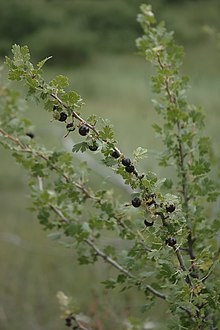



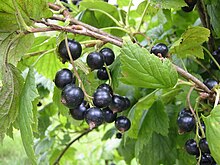






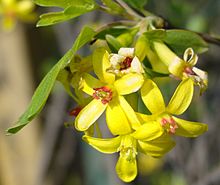
The Grossulariaceae family was established in 1805 by Augustin-Pyrame de Candolle in Flore Française , Troisième Édition, 4 (2), p. 405. The type genus Grossularia Mill. Was published in 1754 by Philip Miller in The Gardeners Dictionary ... Abridged ... , 4th edition with the type species Grossularia hirsuta Mill . Some of the genera with capsule fruits that were incorporated into the Grossulariaceae by A. Cronquist in 1981 now form their own families: Itea as Iteaceae and Escallonia Mutis ex L. f. as Escalloniaceae .
The generic name Ribes was first published in 1753 by Carl von Linné in Species Plantarum , 1, pp. 200-202. Type species is Ribes rubrum L. Synonyms for Ribes L. are: Botrycarpum A. Rich., Botryocarpium Spach , Calobotrya Spach , Cerophyllum Spach , Chrysobotrya Spach , Coreosma Spach , Grossularia Mill. , Liebichia Opiz , Rebis Spach , Ribesium Medik. , Rolsonia Rchb.
The genus Ribes is divided into sub-genera and sections, each with a selection of species:
- Subgenus Berisia :
- Section Berisia :
- Ribes affine Kunth : It occurs in Mexico.
- Alpine currant ( Ribes alpinum L. , Syn .: Ribes dioicum Moench ), origin : Europe, Caucasus
- Ribes armenum Pojark. : It occurs in Armenia .
- Ribes brachybotrys (Wedd.) Jancz. : It occurs in Bolivia and Peru.
- Ribes cuneifolium Ruiz & Pav .: It occurs in Peru.
- Ribes fontaneum Bochkarn. : It occurs in the Primorye region in East Asia.
- Ribes glacial wall. : It occurs in Pakistan, India, Nepal, Bhutan and in China.
- Ribes heterotrichum C.A.Mey. : It occurs in Pakistan in Central Asia, Siberia and in Xinjiang .
- Ribes komarovii Pojark. : It occurs in China, North Korea and the Primorye region .
- Ribes laciniatum Hook. f. & Thomson (Syn .: Ribes tenue Jancz. ): It occurs in India, Bhutan, Nepal, Myanmar and China.
- Ribes luridum Hook. f. & Thomson : It occurs in India, Nepal, Bhutan, Sichuan and Yunnan .
- Ribes maximowiczianum Kom . : It occurs in Japan, Korea, in the Primorye region and in China.
- Ribes maximowiczii Batalin , home: Japan, Korea, China, Manchuria
- Ribes Orientale Desf. : The species occurs in Europe in Greece, also in West Asia, in the Caucasus region, in India, Pakistan, Nepal, Bhutan and in China.
- Ribes vilmorinii Jancz. : It occurs in China.
- Section Davidia :
- Ribes henryi Franch. : It occurs in the Chinese provinces of Hubei and Sichuan .
- Ribes laurifolium Jancz. , Home: Northern China
- Section Diacantha :
- Tienshan currant ( Ribes diacanthum Pall. ), Native to: Eastern Siberia, Mongolia, Manchuria, North Korea
- Ribes pulchellum Turcz. : It occurs in China, Mongolia and Eastern Siberia.
- Ribes saxatile Pall. : It occurs in Siberia, Kyrgyzstan and the Chinese province of Xinjiang .
- Section Hemibotrya :
- Umbel currant ( Ribes fasciculatum Siebold & Zucc. ), Native to: Japan, Korea, North China
- Section Berisia :
- Subgenus Grossularia (Mill.) Pers. (Gooseberries)
- Section Grossularia (Mill.) Nutt.
- Ribes aciculare Sm .: It occurs in Central Asia, Mongolia, Siberia and Xinjiang .
- Ribes alpestre Wall. ex Decne. : It occurs in Afghanistan, Pakistan, India, Nepal, Bhutan and in China.
- Ribes binominatum A.Heller : It occurs in Oregon and California.
- Ribes burejense F.Schmidt : It occurs in China, Mongolia, North Korea and Russia's Far East .
- Ribes curvatum Small : It occurs in the US states of Oklahoma, Texas, Alabama, Arkansas, Georgia, Louisiana and Tennessee.
- Dog gooseberry ( Ribes cynosbati L .; Syn .: Ribes gracile Michx. ), Home: Canada, USA
- Oregon gooseberry ( Ribes divaricatum Douglas ), native to Canada, USA
- Ribes formosanum Hayata : It occurs in Taiwan .
- Ribes hirtellum Michx. , Home: Canada, USA
- Ribes inerme Rydb. : It occurs in western Canada and the western United States.
- Delicate-flowered gooseberry or Colorado gooseberry ( Ribes leptanthum A. Gray ), Origin: USA (Colorado, Utah, New Mexico)
- Ribes missouriense nutt. : It occurs in the central, northern, and eastern US states.
- Snow gooseberry ( Ribes niveum Lindl. ), Home: USA
- Manitoba gooseberry ( Ribes oxyacanthoides L. ), Origin: Canada, USA
- Arizona gooseberry ( Ribes pinetorum Greene ): It occurs in the US states of Arizona and New Mexico .
- Ribes quercetorum Greene : It occurs in Arizona, California and northern Mexico.
- Ribes rotundifolium Michx. : It occurs in the eastern United States.
- Ribes sinanense F. Maek. (Syn .: Ribes grossularioides Maxim. ): It occurs on the Japanese island of Honshu .
- Ribes stenocarpum Maxim. : It occurs in the Chinese provinces of Gansu , Shaanxi , Sichuan and Qinghai .
- Gooseberry ( Ribes uva-crispa L. , Syn .: Grossularia reclinata (L.) Mill. , Ribes grossularia L. , Ribes reclinatum L. ), Origin: Europe, West Asia, North West Africa.
- Ribes velutinum Greene : It is found in the western United States.
- Ribes watsonianum Koehne : It occurs in Alberta , British Columbia , Oregon and Washington.
- Robsonia Section :
- Ribes amarum McClatchie : It occurs in California.
- Ribes californicum Hook. & Arn. : It occurs in two varieties in California.
- Ribes echinellum (Coville) Rehder : It occurs in Florida and South Carolina .
- Sticky gooseberry ( Ribes lobbii A.Gray ), native to: Canada, USA
- Ribes menziesii Pursh : It occurs in Oregon and California.
- Ribes roezlii rule : It occurs in Oregon, Nevada and California.
- Fuchsia-flowered currant ( Ribes speciosum Pursh ): It occurs in California and northern Mexico.
- Ribes thacherianum (Jeps.) Munz : It occurs in California.
- Section Grossularia (Mill.) Nutt.
- Subgenus Grossularioides
- Ribes horridum Rupr. : It occurs in Hokkaido , North Korea, the Chinese province of Jilin , Sakhalin and the Primorye region .
-
Marsh gooseberry ( Ribes lacustre (Pers.) Poir .; Syn .: Ribes grossularioides Michx. Ex Steud. , Ribes oxyacanthoides var. Lacustre Pers. ), Origin: Alaska, Canada, USA
- Ribes montigenum McClatchie : It occurs in British Columbia and the United States.
- Subgenus Parilla :
- Section Andina :
- Ribes bolivianum Jancz. : It occurs in Bolivia and Peru.
- Ribes cucullatum Hook. & Arn. : It occurs in Chile.
- Ribes gayanum (Spach) Steud. (Syn .: Rebis gayanum Spach , Ribes villosum Gay ), home: Chile
- Ribes incarnatum Wedd. : It occurs in Bolivia and Peru.
- Ribes lehmannii Jancz. : It occurs in Ecuador.
- Ribes pentlandii Britton : It occurs in Bolivia.
- Ribes trilobum Meyen : It occurs in Chile.
- Parilla section :
- Ribes magellanicum Poir. : It occurs in Argentina and Chile.
- Ribes punctatum Ruiz & Pav .: It occurs in Argentina and Chile.
- Ribes valdivianum Phil . : It occurs in Argentina and Chile.
- Section Andina :
- Subgenus Ribes
- Botrycarpum Section :
- Canadian currant ( Ribes americanum Mill. ), Origin: Canada, USA
- Ribes bracteosum Douglas , home: Alaska, Canada, USA
- Ribes dikuscha fish. ex Turcz. (Syn .: Ribes appendiculatum Krylov ): It occurs in Siberia and in Russia's Far East .
- Ribes fragrans Pall. (Syn .: Ribes graveolens Bunge ): It occurs in Mongolia, Siberia and Russia's Far East .
- Ribes × fuscescens (Jancz.) Jancz. (= Ribes bracteosum × Ribes nigrum , Syn .: Ribes bracteosum var. Fuscescens Jancz. ): It is only known from culture.
- Ribes hudsonianum Richardson : It occurs in two varieties in Canada and in the United States.
- Ribes janczewskii Pojark. : It occurs in Kazakhstan, Kyrgyzstan and Tajikistan.
- Ribes japonicum Maxim. : It occurs on the Japanese islands of Honshu, Hokkaido and Shikoku.
- Black currant ( Ribes nigrum L. ): It is common in Eurasia .
- Ribes pauciflorum Turcz. ex Pojark. : It occurs in China, Siberia and Russia's Far East .
- Ribes procumbens Pall. : It occurs in Siberia, China, Mongolia and Russia's Far East .
- Ribes turbinatum Pojark. : It occurs in the Altai and Kazakhstan.
- Ribes ussuriense Jancz. : It occurs in the Chinese province of Jilin , in North Korea and in the Primorye region .
- Ribes viburnifolium A.Gray : It occurs in California and in the Mexican state of Baja California.
- Section Calobotrya :
- Ribes acerifolium Howell (Syn .: Ribes howellii Greene ): It occurs in British Columbia , Washington, Oregon and Idaho .
- Ribes × bethmontii Jancz. (= Ribes malvaceum × Ribes sanguineum )
- Ribes ciliatum Humb. & Bonpl. ex Schult. : It occurs in Mexico, Guatemala and Costa Rica.
- Ribes malvaceum Sm . : It occurs in California and northern Mexico.
- Ribes neglectum Rose : It occurs in the Mexican state of San Luis Potosí .
- Ribes nevadense Kellogg : It occurs in California, Nevada and Oregon.
- Blood currant ( Ribes sanguineum Pursh ), native to: Canada, USA
- Ribes viscosissimum Pursh (Syn .: Ribes hallii Jancz. ): It occurs in western Canada and in the western United States.
- Ribes wolfii Rothr. (Syn .: Ribes mogollonicum Greene ): It occurs in the US states of Washington, Oregon, Idaho, Utah, Colorado, New Mexico and Arizona.
- Cerophyllum Section :
- Desert currant ( Ribes cereum Douglas ), home: Canada, USA
- Ribes mescalerium Coville : It occurs in Texas, New Mexico and the Mexican state of Chihuahua .
- Fargesia section
- Section Heritiera :
- Ribes erythrocarpum Coville & Leiberg : It occurs in Oregon.
- Skunk currant ( Ribes glandulosum Grauer ; Syn .: Ribes prostratum L'Hér. ), Origin: Alaska, Canada, USA
- Ribes laxiflorum Pursh (Syn .: Ribes affine Douglas ex Bong. , Ribes coloradense Coville ): It occurs in the western United States, western Canada and Russia.
- Ribes sachalinense (F.Schmidt) Nakai : It occurs in Japan and in Sakhalin .
- Microsperm section :
- Ribes ambiguum Maxim. : It occurs in Japan and Sichuan.
- Ribes section :
- Ribes altissimum Turcz. ex Pojark. : It occurs in China, Mongolia and Russia's Far East . Some authors also call it the variety Ribes petraeum var. Altissimum (Turcz. Ex Pojark.) Jancz. viewed.
- Ribes × futurum Jancz. (= Ribes rubrum × Ribes warszewiczii )
- Ribes griffithii Hook. f. & Thomson : It occurs in Sikkim , Nepal, Bhutan, Tibet and in the Chinese provinces of Sichuan and Yunnan.
- Ribes himalense Royle ex Decne. : It occurs in Pakistan, India, Nepal, Bhutan and in China.
- Ribes × holosericeum Otto & A.Dietr. (= Ribes petraeum × Ribes spicatum )
- Ribes × koehneanum Jancz. (= Ribes multiflorum × Ribes rubrum )
- Ribes latifolium Jancz. : It occurs in Japan, in Russia's Far East and in the Chinese province of Jilin .
- Ribes longeracemosum Franch. : It occurs in several varieties in China.
- Ribes mandshuricum (Maxim.) Kom . : It occurs in China, North Korea and Russia's Far East .
- Ribes meyeri Maxim. : It occurs in Central Asia, in western Siberia, in Mongolia and in the Chinese province of Xinjiang .
- Ribes moupinense franch. : It occurs in China in the provinces of Anhui, Hubei, Gansu, Guizhou, Shaanxi, Sichuan and Yunnan.
- Tassel currant ( Ribes multiflorum Kit. Ex Schult. ), Origin: Sardinia, Italy, Croatia, former Yugoslavia, Greece, Bulgaria
- Ribes palczewskii (Jancz.) Pojark. : It occurs in China, Siberia and Russia's Far East . It is also called the subspecies Ribes spicatum subsp. palczewskii (Jancz.) Malyschev placed at Ribes spicatum .
- Ribes pallidiflorum Pojark. : It occurs in Russia's Far East and North Korea.
- Rock currant ( Ribes petraeum Wulf. ): It occurs in several varieties in Europe, Asia and Northwest Africa.
- Red currant ( Ribes rubrum L. ), Origin: Europe
- Spiked currant ( Ribes spicatum E. Robson , Syn .: Ribes warszewiczii Jancz. ), Origin : Europe, Siberia, Manchuria
- Ribes sad Pall. : It occurs in China, Japan, Korea, Siberia, Russia's Far East , Canada and the United States.
- Symphocalyx section
- Gold-currant ( Ribes aureum Pursh , Syn .: Ribes odoratum H.L.Wendl. = Fragrant currant), home: Canada, USA
- Botrycarpum Section :
The genus includes around 140 to 160 species worldwide. The main distribution area is the temperate climatic areas of the northern hemisphere , but there are also some species in the Andes . 59 species occur in China , 25 of them only there. 53 species occur in North America. In contrast, only a few species are native to South America.
Horticultural varieties:
- Jostabeere , Josta- or Jochelbeere ( Ribes × nidigrolaria Rud.Bauer & A.Bauer ): It is a horticultural cross ( hybrid ) of Ribes nigrum × Ribes divaricatum × Ribes uva-crispa .
- Culture gooseberries are from the two species Ribes uva-crispa and Ribes hirtellum emerged.
use
Individual Ribes species are used as fruit bushes, ornamental plants and for the production of perfume:
- The fruits of the red currant (with red and white varieties), black currant and gooseberry are used as fruit . The josta berry was bred by crossing the black currant with the gooseberry .
- The black currant flowers are used in perfume production.
- In particular, varieties of the alpine currant, the gold currant and the blood currant are ornamental plants in parks and gardens, which are planted both individually and as a hedge.
further reading
- Claude-Antoine Thory: monograph; ou, Histoire naturelle du genre groseillier: contenant la description, l'histoire, la culture et les usages de toutes les groseilles connues ... , Verlag P. Dufart, 1829: PDF at Google Books, Google Books Online.
- LM Donoghue & MJ Donoghue: Molecular phylogeny and biogeography of Ribes (Grossulariaceae), with an emphasis on gooseberries (subg.Grossularia) , in Syst. Bot. 29, 2004, 77-96.
swell
- The gooseberry family (Grossulariaceae) on the AP website (section description, systematics)
- The gooseberry family (Grossulariaceae) at DELTA by L. Watson & MJ Dallwitz. . (Section description)
- Jin-tang Pan, Cuizhi Gu, Shumei Huang, Chao-fen Wei, Shu-ying Jin, Lingdi Lu, Shinobu Akiyama, Crinan Alexander, Bruce Bartholomew, James Cullen, Richard J. Gornall, Ulla-Maj Hultgård, Hideaki Ohba & Douglas E. Soltis: Saxifragaceae in the Flora of China , Volume 8, p. 428: Ribes - Online. (Section description, systematics and dissemination)
- Nancy R. Morin: Grossulariaceae in the Flora of North America , Volume 8, 2009 from p. 8: Online. (Section Description and Distribution)
- O. Sebald, S. Seybold, G. Philippi: The fern and flowering plants of Baden-Württemberg , Volume 3, Ulmer Verlag, Stuttgart 1992, ISBN 3-8001-3314-8
- Walter Erhardt among others: The big pikeperch. Encyclopedia of Plant Names . Volume 2. Verlag Eugen Ulmer, Stuttgart 2008, ISBN 978-3-8001-5406-7
Individual evidence
- ↑ John Borg: Cultivation and diseases of fruit trees in the Maltese Islands. Govt. Printing Office, Malta 1922.
- ↑ DL Domondon, J. Poppe, LJLD van Griensven: Fruit optimization with wastes used for outdoor cultivation of king stropharia. In: Science and cultivation of edible fungi . Volume 2, 2000, pp. 909-918.
- ↑ Günther Drosdowski (Ed.): Duden "Etymologie": Dictionary of origin of the German language . 2nd edition, Dudenverlag, Mannheim 1989, ISBN 3-411-20907-0
- ^ Gustav Hegi: Illustrated flora of Central Europe . Volume IV, reprint. Parey, Berlin 1975, ISBN 3-489-70021-X , p. 43 f.
- ↑ a b FAOSTAT production statistics , accessed on January 25, 2018 .
- ^ Grossulariaceae in the Germplasm Resources Information Network (GRIN), USDA , ARS , National Genetic Resources Program. National Germplasm Resources Laboratory, Beltsville, Maryland. Retrieved February 15, 2017.
- ↑ a b c d e f g h i j k l m n o p q r s t u v w x y z aa ab ac ad ae af ag ah ai aj ak al am an ao ap aq ar as at au av aw ax ay az ba bb bc bd be bf bg bh bi bj bk bl bm bn bo bp bq br bs bt bu bv bw bx by bz ca cb cc cd Ribes in the Germplasm Resources Information Network (GRIN), USDA , ARS , National Genetic Resources Program. National Germplasm Resources Laboratory, Beltsville, Maryland. Retrieved February 15, 2017.
- ↑ Jaakko Jalas, Juha Suominen, Raino Lampinen, Arto Kurtto: Atlas florae europaeae . Volume 12 (Resedaceae to Platanaceae). P. 237, Helsinki 1999, ISBN 951-9108-12-2
